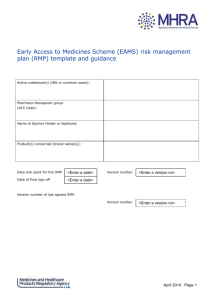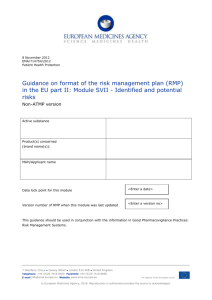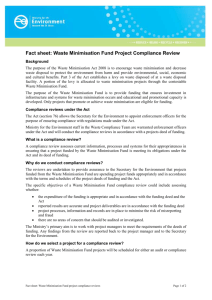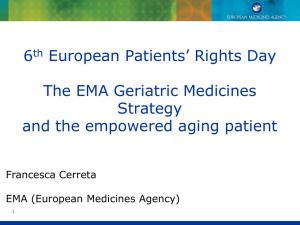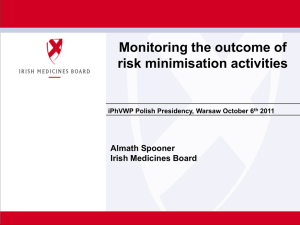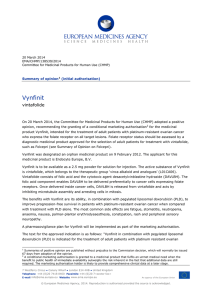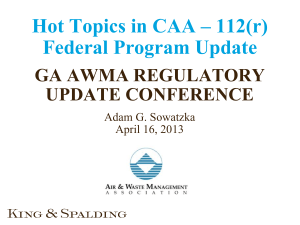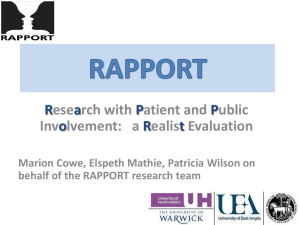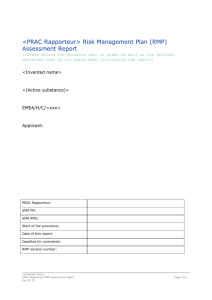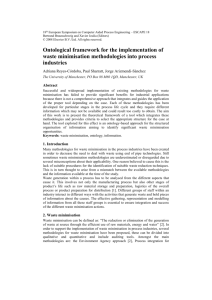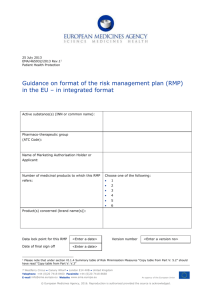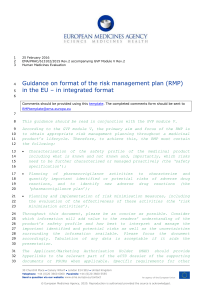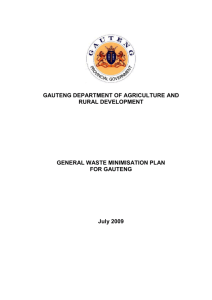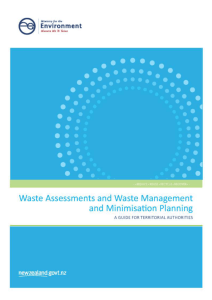Guidance on format of the risk-management plan in the European
advertisement
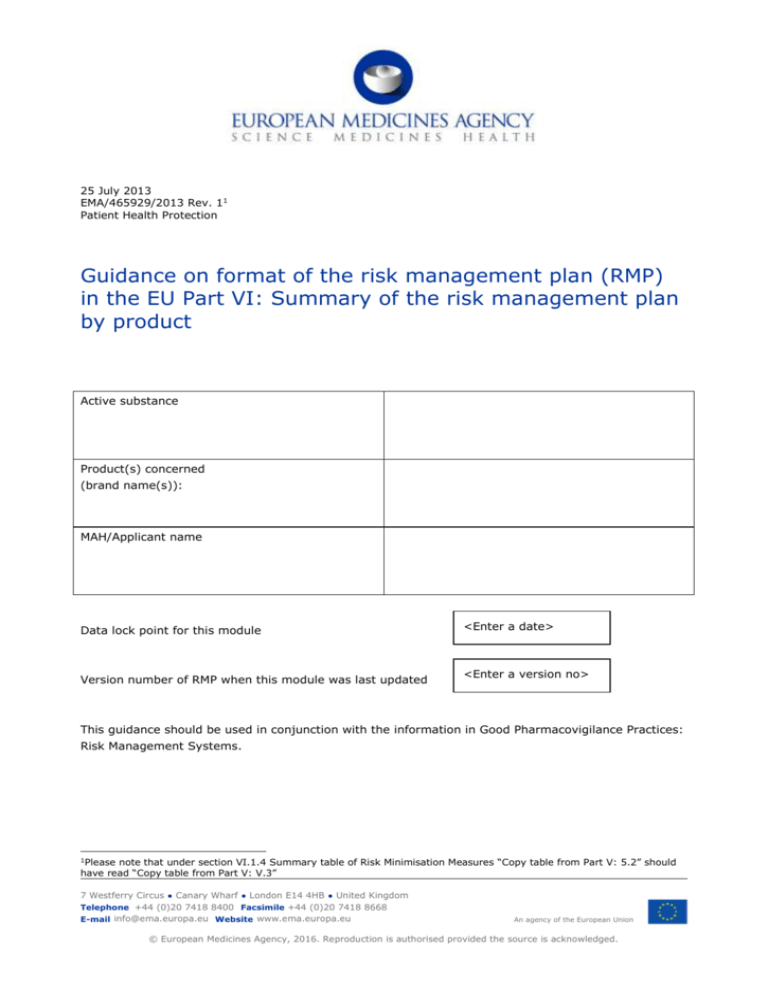
25 July 2013
EMA/465929/2013 Rev. 11
Patient Health Protection
Guidance on format of the risk management plan (RMP)
in the EU Part VI: Summary of the risk management plan
by product
Active substance
Product(s) concerned
(brand name(s)):
MAH/Applicant name
Data lock point for this module
Version number of RMP when this module was last updated
<Enter a date>
<Enter a version no>
This guidance should be used in conjunction with the information in Good Pharmacovigilance Practices:
Risk Management Systems.
1Please
note that under section VI.1.4 Summary table of Risk Minimisation Measures “Copy table from Part V: 5.2” should
have read “Copy table from Part V: V.3”
7 Westferry Circus ● Canary Wharf ● London E14 4HB ● United Kingdom
Telephone +44 (0)20 7418 8400 Facsimile +44 (0)20 7418 8668
E-mail info@ema.europa.eu Website www.ema.europa.eu
An agency of the European Union
© European Medicines Agency, 2016. Reproduction is authorised provided the source is acknowledged.
A separate RMP Part VI should be provided for each product in the RMP.
VI.1
Elements for summary tables in the EPAR
VI.1.1
Summary table of Safety concerns
Copy table from Part I: SVIII
Summary of safety concerns
Important identified risks
<> List
Important potential risks
<> List
Missing information
<> List
VI.1.2
Table of on-going and planned studies in the Post-authorisation
Pharmacovigilance Development Plan
Copy table from III.5.1.
Study/activity
Objectives
Type, title and
Safety concerns
Status (planned,
Date for
addressed
started)
submission of
interim or final
category (1-3)
reports (planned
or actual)
<E.g. CRUCIAL
<E.g. To
<E.g. Bradycardia,
<E.g. Protocol
<E.g. Interim
Cancer Registry at
investigate long
thrombosis,
submitted to
reports planned
University College
term survival,
leukopenia,
PRAC>
June 2013, 2017
IdAho Liver unit
time to
use in patients
Final study report
(non-
progression,
with renal
Dec 2020>
interventional
safety profile and
impairment, long
cohort, 3)>
QoL in patients
term safety>
with primary liver
cancer or solid
tumour
metastases>
<E.g. Validation of
<E.g. Comparison
<E.g.
<E.g. Planned
<E.g. Final study
antibody test
of Supertest kit
Development of
start March 2013>
report December
(non-clinical, 3)>
with current gold
antibodies>
2013>
standard>
VI.1.3
Summary of Post authorisation efficacy development plan
Copy table IV.3 from Part IV
Study (type and
study number)
Objectives
Efficacy
Status
Date for
uncertainties
submission of
addressed
interim or final
reports
Guidance on format of the risk management plan (RMP) in the EU Part VI: Summary of
the risk management plan by product
EMA/465929/2013
Page 2/7
VI.1.4
Summary table of Risk Minimisation Measures
Copy table from Part V: V.3.
Safety concern
Routine risk minimisation
Additional risk minimisation
measures
measures
VI.2
Elements for a Public Summary
VI.2.1
Overview of disease epidemiology
(Maximum 150 words per indication)
Abbreviated lay language version of RMP Part II Module I.
VI.2.2
Summary of treatment benefits
The summary of treatment benefits should be in lay language and nonpromotional. The text should not exceed a maximum of 200 words (up to
300 if multiple indications). The following should be considered for
inclusion:
Describe briefly each pivotal study, including total participant
numbers (randomised figure where applicable). Explain the primary
endpoint in lay language.
If there are multiple indications, use bullet points to separate
the studies per indication. If there are several studies for one
indication with a similar design, in some cases these may be
described together and the total patient numbers combined to stay
concise.
For each study, describe the primary endpoint results directly
after the description of the study (either in the same paragraph,
or a separate paragraph if needed). When using percentages, give
patient numbers in brackets.
<E.g. The average survival time for patients in the main study treated with 475 mg of drug x in
addition to drugs y and z increased by 19.5 months to 55.5 months compared with treatment 2 (36
months) and 17 months (57.5 months) compared with treatment 3 (40.5) months.>
VI.2.3
Unknowns relating to treatment benefits
(1 short paragraph per indication of 50 words maximum)
A short summary of the applicability of efficacy to all patients in the
target population can be provided in lay language. This should be a
précised version of Part IV IV.1 written for the lay reader. It should
describe very briefly any relevant parts of the target population where
experience is limited and whether efficacy is expected to be different
in these people – e.g. factors such as age, sex, race, and organ
Guidance on format of the risk management plan (RMP) in the EU Part VI: Summary of
the risk management plan by product
EMA/465929/2013
Page 3/7
impairment. If there is evidence that efficacy is either enhanced or
reduced (e.g. ACE inhibitors and the Afro-Caribbean population) this
should be stated.
<E.g. In the main and supporting studies nearly all patients were white Caucasians aged between 52
and 86 with most patients aged over 65. There is no evidence to suggest that results would be any
different in non-white patients or in younger patients unable to tolerate high dose chemotherapy.>
VI.2.4
Summary of safety concerns
Important identified risks
Risk
What is known
Preventability
<Safety concern in lay language
<Brief summary in lay
<Whether risk can be minimised
(medical term)>
language>
or mitigated, and how>
<E.g. Damage to the nerves in
<E.g. Approximately one in two
<E.g. Yes, by monitoring for
hands and feet
people treated with x will
early symptoms >
(peripheral neuropathy)>
experience some form of nerve
damage which may increase to
three out of four people after 12
months of treatment. The nerve
damage varies from mild
tingling and altered sensation to
irreversible disabling damage in
the most severe cases. Early
symptoms usually resolve or
improve upon dose adjustment
or discontinuation of therapy. >
<E.g. Blood clots
<E.g. These may affect the
<E.g. Yes with preventative
(thromboembolic events
arteries or veins. In the veins
anti-thrombotic medicines >
{TEE})>
this may lead to a painful
swelling of the legs (deep vein
thrombosis) and very
occasionally life threatening or
fatal clots in the lungs. Clots in
the arteries may lead to a heart
attack or stroke – particularly in
patients who already have
problems with their arteries.
Patients with cancer who are
being treated with oestrogen are
already at higher risk of blood
clots so it is difficult to assess
what extra risk is caused by x.>
Guidance on format of the risk management plan (RMP) in the EU Part VI: Summary of
the risk management plan by product
EMA/465929/2013
Page 4/7
Important potential risks
What is known (Including reason why it is considered a
Risk
potential risk)
<E.g. Secondary primary
<E.g. Patients treated with X may be at an increased risk of
cancers>
developing new cancers. There are theoretical mechanisms and
more patients treated with X developed new cancers than those not
treated with X, but this could also be due to the fact that they live
longer.>
Missing information
Risk
What is known
<E.g. Limited information on use
<E.g. X itself is not eliminated to any significant extent by the
in patients with kidney
kidney so it is unlikely that kidney impairment will lead to
impairment>
problems. Some of its metabolites are eliminated by the kidney so
it is recommended that patients with severe renal impairment are
monitored carefully. >
VI.2.5
Summary of risk minimisation measures by safety concern
All medicines have a Summary of Product Characteristics (SmPC) which provides physicians,
pharmacists and other health care professionals with details on how to use the medicine, the risks and
recommendations for minimising them.
An abbreviated version of this in lay language is provided in
the form of the package leaflet (PL). The measures in these documents are known as routine risk
minimisation measures.
The Summary of Product Characteristics and the Package leaflet for X can be found in the X’s EPAR
page
<This medicine has no additional risk minimisation measures>
<This medicine has special conditions and restrictions for its safe and effective use (additional risk
minimisation measures). Full details on these conditions and the key elements of any educational
material can be found in Annex II of the product information which is published in X’s EPAR page; how
they are implemented in each country however will depend upon agreement between the manufacturer
and the national authorities.
These additional risk minimisation measures are for the following risks:
Safety concern in lay terms (medical term)
Risk minimisation measure(s)
Objective and rationale
Summary description of main additional risk minimisation measures
key points
<E.g. Damage to the nerves in hands and feet (peripheral neuropathy)
Healthcare Professional and patient education
Objective and rationale
Guidance on format of the risk management plan (RMP) in the EU Part VI: Summary of
the risk management plan by product
EMA/465929/2013
Page 5/7
Risk minimisation measure(s)
Patients and HCPs to understand the risk of peripheral neuropathy and the procedures related to the
appropriate management of this risk to minimise its occurrence and its severity.
Proposed action:
HCP educational materials to be provided to prescribing physicians and pharmacists including advice
on:
Use of electromyogram prior to and during treatment
Importance of adherence to dosing recommendations
Management of neuropathy including dose reduction and treatment discontinuation
Direct HCP communication prior to launch (‘Dear HCP’ letter).
Patient booklet will inform patients what the symptoms of nerve damage are and the importance of
informing their HCP if any occur>
VI.2.6
Planned post authorisation development plan
From combined summary tables in Part III and Part IV
List of studies in post authorisation development plan
Study/activity
Objectives
Safety concerns
Planned date for
Status
(including study
/efficacy issue
submission of
number)
addressed
(interim and)
final results
Studies which are a condition of the marketing authorisation
<None of the above studies are conditions of the marketing authorisation>
< <study(ies)> <is><are> <a> condition<s> of the marketing authorisation
Mention all studies in the table (including specific obligations) which
are conditions of the MA.
VI.2.7
Summary of changes to the Risk Management Plan over time
Table 1. Major changes to the Risk Management Plan over time
Version
Date
Safety Concerns
At time of authorisation
Identified Risks
dd/mm/yyyy
Potential Risks
Comment
Missing information
<E.g. 7.0>
<E.g. 17/08/2012>
<E.g.Allergic conditions
<E.g. The previous
added as an identified
term hypersensitivity
risk
was updated to allergic
Hypersensitivity
conditions to include
Guidance on format of the risk management plan (RMP) in the EU Part VI: Summary of
the risk management plan by product
EMA/465929/2013
Page 6/7
Version
Date
Safety Concerns
Comment
removed as an
angioedema and
identified risk
urticarial>
Severe infection added
as an identified risk
Convulsions added as a
potential risk>
Guidance on format of the risk management plan (RMP) in the EU Part VI: Summary of
the risk management plan by product
EMA/465929/2013
Page 7/7
